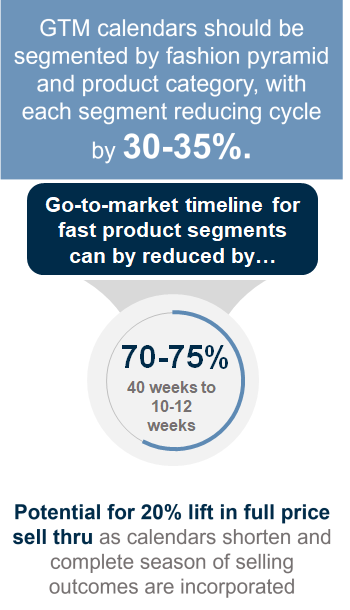Navigating the Rapid Pace of Fashion
Back to All InsightsThe fashion retail industry is seeing significant changes propelled by rapid advancements in technology, evolving consumer behavior, and heightened competitive pressures. It is imperative for companies to proactively adapt to remain relevant and be at the forefront of modern consumers’ minds, especially given the countless brands that consumers can choose from.
Increasing numbers of companies continue to chip away at the age-old challenge of reducing speed-to-market from the traditional 40 weeks with the fast-fashion norm recalibrated to regularly introducing products in a matter of weeks at scale.
Shein has achieved $45B in sales and doubled its profits in the past year through its keen ability to tune into the cultural zeitgeist and swiftly adapt to it.
Shein, the disruptive e-commerce and fashion retailer, is an example that has shattered the mold of how traditional retailers operate by putting technology, data, and the customer at the core of their operating model and decisions. Although with any rapid rise and associated scrutiny, Shein has faced their fair share of challenges; however, there are elements of the model that the competition can adopt as they retool their businesses to succeed in the changing landscape.
Consumer Voice in Design and Merchandising
In order for brands to be successful in this changing industry, they must follow, understand, and synthesize consumer preferences into their decisions. Companies need to be in tune with what consumers want and action on it. Consumers can play a role at the beginning of the design process instead of only at the end once the product is launched.
Consumer Surveys/Reviews
Consumer surveys may be used as a starting point in the design process and feedback from reviews of their current products can be leveraged as a critical pipeline of perspectives.
During the upfront design stage, prior to any physical sample creation or review, design concepts may be shared with consumers to gauge a variety of reactions from general interest, preference of one style over another, color choice offerings for a given silhouette, and much more. This can then be incorporated in the next decision of what physical garments to make and, ultimately, proceed to test. Consumer reviews of prior purchases may mention callouts about fit, color, or quality that can be addressed in the next design iteration or apply to multiple styles in the go-forward offering.
Product Testing
Companies should seek signals from their existing and aspirational customers and treat these signs as a true north, using them to inform decisions. Input from what is resonating best and what consumers are voting for can be used to determine which products to produce and where to invest inventory capital.
For example, retailers can manufacture a small batch of units to be used as a performance test during a trial period. If the style selling velocity is significant in relation to the number manufactured, it is likely to work, and companies can then work with several suppliers to mass produce it. The low number of initial manufactured styles enables daily product testing while generating repeated engagement from consumers and forging deep connections.

Merchandising
Customer input and feedback also extends beyond the product development process to merchandising and assortment decisions. Retailers can leverage selling data to determine where to invest open to buy dollars and which products to feature on their homepage, all of which improve sell-thru and minimize inventory risk.
Customer Analytics
Cultivating and capturing the voice of the customer requires companies to have resources and investments – systems, analysts, and leaders – to receive, review, and react to this consumer data. And they must be enabled to act swiftly and decisively in response to the insights the data reveals.
Traditionally, designers and merchandisers may have some access to customer data, but the clear analysis of learnings from the data are rarely put in place consistently and with conviction in the process. Moving forward brands need to bolster belief in the customer data to drive in-the-moment decision making.
This mindset shift will also minimize risk and reduce tied up capital as it can prevent companies from manufacturing items with lower consumer interest, likely lower turn, and increased markdowns.
Supplier Partnerships
Role of Sampling
Today’s companies continue to adapt to meet the evolving needs and desires of digital consumers, from hosting virtual fashion shows to leveraging the metaverse to digitally try on clothes. Considering brands’ proficiency in adapting strategies to cater to digital consumers, it should be possible for them to pivot their internal front-end processes to be more digitally focused. Specifically, brands need to be bold in rethinking the role that sampling plays in their design process. In the past, retailers used physical samples throughout each stage of the design process for the necessary approvals to move forward. However, this adds unnecessary time and extra costs to the product development cycle. It is imperative for retailers to leverage digital samples to expedite different points in the process, especially for items in the fashion and trend sections of the assortment architecture where hitting the trend to customer timing perfectly is crucial. Visioning, concepting, and iterating can shift to digital and physical samples can be leveraged towards the end of the process.
Shein, for instance uses digital samples to do fast proto reviews to determine which products to test manufacture: Shein manufactures only 100 units that are used as a performance test during a trial period. Once Shein decides to mass produce a style, it will then use physical samples to approve new fit blocks.
Digital samples can reduce sampling time by ~85%, from a few weeks to a matter of days.
Digital samples provide an adaptable, iterative approach to the design process and incorporating a heavy reliance on digital samples for as much of the design process as possible enables the front-end to be as nimble as the back-end of bulk production and replenishment.
Go to Market Timeline
 Clear accountability expectations combined with a trust in robust data, dramatically improves the speed to introduce products into the market as there is less back and forth among designers and mandatory review as the company has faith in the data it has gathered from consumers. The use of digital samples also allows companies to iterate on many designs quickly. With such an approach it’s possible to bring products to market in 14 days versus the 40 weeks for traditional retailers. It is imperative that U.S. brands action to shorten lead times and improve operational innovation to continue to captivate consumer.
Clear accountability expectations combined with a trust in robust data, dramatically improves the speed to introduce products into the market as there is less back and forth among designers and mandatory review as the company has faith in the data it has gathered from consumers. The use of digital samples also allows companies to iterate on many designs quickly. With such an approach it’s possible to bring products to market in 14 days versus the 40 weeks for traditional retailers. It is imperative that U.S. brands action to shorten lead times and improve operational innovation to continue to captivate consumer.
Improving across the three dimensions, voice of the customer, strong supplier relationships, and use of digital samples, can significantly propel innovation and accelerate the GTM timeline.
Social Media Marketing Strategies
Social media marketing is essential for ensuring a brand’s success in today’s digital landscape as consumers are spending an increased amount of time on social media channels, such as Instagram and TikTok. It is crucial for brands to strategically inject themselves into customers’ journey to purchase in order to stay at the forefront of consumers’ minds and as such having the appropriate social media marketing strategy to do so is critical. It is also important for brands to consider the implication of the House passing a bill that would lead to a nationwide ban of TikTok (the bill now goes to the Senate where the outcome is unknown) as this could have a significant impact on brands’ social media marketing strategies.
Micro-Influencers
Companies can increase customer engagement on social media by being very deliberate with which influencers they partner with.
- Luxury brands typically partner with celebrity influencers as this corresponds to the higher fashion aesthetic and message that they are trying to convey.
- However, Shein uses many micro influencers to enforce its messaging of being an affordable, accessible brand.
Micro-influencers have a 60% higher engagement compared to larger influencers.
Micro-Influencers
- Shein’s micro influencers have a following that are closely tied to its target consumers: influencers must have a following that is:
– Primarily female,
– 70 percent US based, and
– between the ages of 18 and 33. - This approach is part of Shein’s oft-discussed arsenal, but Fast fashion company Lefties has also used this micro influencer strategy to successfully compete and broaden appeal to more consumers.
- Lefties’ social media marketing is a different approach than the higher fashion aesthetic of its parent brand Zara, further indicating that aspects of the Shein model are applicable and influencing how other retailers operate.
Organic Influencers
For brands targeting a younger demographic, creating an organic influencer pipeline can add authenticity to the bond created between influencer and followers.
This bond can lead to a stronger sense of loyalty and relatability while also reducing influencer turnover. To do this, companies can launch programs such as college ambassadors. Selected ambassadors can receive a personalized discount code for followers to enter at checkout, enabling the company to track the influencers’ performance.
Different KPI hurdles can be implemented for an ambassador; if they can generate a significant number of sales, the ambassadors then graduate to become influencers.
Selecting the right influencers, whether macro or micro, whose following resonates with the brand's target audience, can significantly boost engagement and brand affinity. As the digital landscape continues to evolve, embracing innovative social media marketing strategies remains essential for brands aiming to thrive in the ever-changing marketplace.
Call to Action
Fashion has undoubtedly gotten faster and delivering compelling trend-right product immediately is more imperative than ever. Companies need to anchor on data-driven decisions and customer insights as the true north.
Shein is an example of how customer perspectives and continuous data analysis combine for more optimal impact. Companies can leverage several elements of the Shein model:
- consumer as an extension of design process
- supplier partnerships
- use of digital samples,
- and a purposeful social media strategy.
By focusing on these key areas, brands can reduce capital exposure and inventory risk, elevate marketing position, and improve their go-to-market timeline.
By Abhinav Chandra, Joanna Rangarajan, Rajesh Swaminathan, and Erika Dagum
